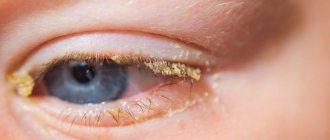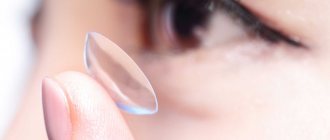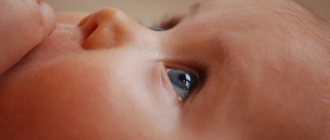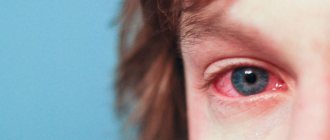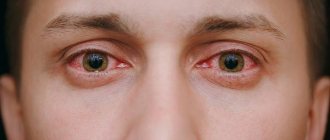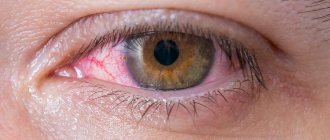Category: Children Published 02/03/2018 · Comments: · Reading time: 5 min · Views: Post Views: 2,531
Chickenpox on the eye (varicella) is a viral disease that is transmitted by airborne droplets to both children and adults. Refers to herpetic infections; with timely treatment, it does not cause any dangerous consequences. Next, we will consider the causes, symptoms of the disease, how to treat chickenpox in a child’s eye, as well as preventive measures.
Chickenpox in children - how dangerous is the disease?
Chickenpox is a disease that is transmitted by airborne droplets and belongs to the herpes viruses. It is more easily tolerated in childhood, but this does not make the disease any less dangerous, because 30% of brain inflammation is associated with complications after chickenpox. During treatment, it is very important to monitor all changes occurring in the child’s health.
In addition to regularly measuring the temperature and treating ulcers on the child’s skin, parents need to be able to see and respond to the signals that the baby gives through his behavior. If he often presses his hands to his head, closes his eyes from the light, this may indicate severe headaches, and the weakness of the body becomes more pronounced. In this case, you need to call a doctor again to get qualified help, since if the condition worsens, symptoms of croup and suffocation may appear, and herpetic viral conjunctivitis may appear.
When treating chickenpox, it is necessary to carefully treat the sores. Make sure that the child does not scratch them, as there is a risk of infection with staphylococcus, streptococcus against the background of a decrease in the barrier properties of the immune system. Such infections lead to the formation of furunculosis, impetigo, and if they enter the bloodstream they can cause sepsis and meningitis.
Prevention
Avoiding contact with sick people helps avoid infection with chickenpox. This is especially true for people who do not have immunity to type 3 herpes infection. Children must be taught proper personal hygiene. Treating your hands with antiseptic solutions after contact with the rash helps prevent the spread of chickenpox to the eyes.
A strong immune system can prevent the development of infection. Proper nutrition contributes to its development. The diet of a child and an adult should include fresh vegetables and fruits, dairy and meat products. Particular attention should be paid to walking in the fresh air and playing sports.
- What to do if chickenpox appears in the mouth?
Why does conjunctivitis appear with chickenpox?
Herpetic viral conjunctivitis develops simultaneously with chickenpox or at the end of the incubation period. The reason the virus affects the mucous membranes is a decrease in the body’s protective functions. The symptoms of conjunctivitis with chickenpox in a child are noticeable, and it is impossible to miss it, as it causes great anxiety to the baby.
Symptoms of herpetic viral conjunctivitis in children:
- pain appears when blinking, itching and redness (usually the eyes are affected alternately), severe lacrimation;
- sensitivity to light increases, there is a significant decrease in visual acuity;
- the mucous membrane and eyelids are affected by painful ulcers and blistering rashes.
Treatment of conjunctivitis that occurs at the end of the incubation period, after chickenpox in a child, should be started as soon as possible, because it does not go away quickly, and the sooner help is provided to the baby, the better. It will be possible to completely get rid of the disease, redness of the eyes, only after a couple of weeks or a month. It all depends on the capabilities of the body.
Characteristic clinical signs
Redness of the sclera is one of the first manifestations of the disease.
If chickenpox appears on the mucous membrane of the eye in a child or adult, then pronounced symptoms are present. First, the patient notices that the visual organs are slightly red and inflamed. Soon the red area becomes covered with pathological spots, which are round and flat. Subsequently, a bubble is formed, filled inside with liquid exudate. If the latter is not damaged, then after a couple of days it becomes covered with a crust, which soon falls off on its own. With chickenpox, the patient most often notices that one visual organ is covered in rashes and reddened; less often, the pathological process affects both eyeballs at once. As a result of the disease, a person’s eyes hurt severely and other pathological symptoms occur:
- redness of the eyeball;
- severe itching sensations;
- lacrimation;
- fear of bright light;
- clouding of the cornea;
- difficult vision.
Diagnosis of conjunctivitis with chickenpox in children
To receive adequate treatment, it is necessary to diagnose herpetic viral conjunctivitis in the laboratory, because the range of therapeutic measures depends on the type of disease. The fact is that chickenpox is of viral origin, but then a bacterial infection can also join it.
How is conjunctivitis diagnosed after chickenpox:
- external examination by a specialist who records the condition of the eyeball, conjunctiva, and the presence of discharge;
- bacteriological examination of a smear from the conjunctiva;
- cytological examination of a scraping or smear;
- examination of tear fluid and blood serum.
If bacteria are present in the biomaterial, antibacterial treatment will be prescribed. The causative agent of the disease can also be identified by cytological examination, which at the cellular level helps determine the viral or bacterial nature of the disease. Sometimes, if a viral origin of the disease is suspected, a serological test may be prescribed, in which the discharge is checked for the presence of antigens and antibodies.
Many parents are faced with the inability to get an appointment with an ophthalmologist because their child has chickenpox, although consultation with a specialist is really necessary to receive adequate treatment. In this case, you need to contact a hospital rather than a local specialist. Chickenpox examination and subsequent treatment will be carried out in the isolation ward. Conjunctivitis after chickenpox is dangerous due to the appearance of other complications: the development of dendritic keratitis, clouding of the cornea, etc., so it is important to start treatment in a timely manner.
Features of the development of the pathological condition
Visual acuity becomes noticeably worse if the disease has been advanced.
Infectious blisters on swollen eyelids and mucous membranes of the organ of vision with chickenpox appear in waves. They are filled with clear liquid. The main danger is the addition of a secondary bacterial agent, then the rash festers, the cornea becomes cloudy, the eyelid swells and turns red. And when the process starts, ulcers and erosions appear with a feeling of severe pain and burning in the eyes. As a result, visual acuity may be significantly reduced.
How to recognize the problem in time?
It is important not to confuse the symptoms of chickenpox conjunctivitis with other eye infections. Characteristic manifestations are:
- swollen, reddened eyelids;
- inflammation of the lacrimal canal, accompanied by constant lacrimation and photophobia;
- wave-like appearance of vesicular rashes that take a long time to heal, itch and burn.
Associated symptoms indicating the cause of swollen eyes:
High temperature is one of the possible additional signs of the disease.
- heat;
- rash on the oral mucosa and labia, all over the body, but not on the feet and palms;
- lack of appetite and weakness.
How is conjunctivitis treated for chickenpox in children?
Depending on the characteristics of the disease, specialists prescribe treatment aimed at alleviating symptoms and combating viral and bacterial infections. Remember that traditional medicine recipes (for example, treating the eyes with warm decoctions of parsley, chamomile, calendula and other herbs that relieve redness and itching) will only be effective if used in combination with medicinal drugs. Do not risk your child’s health; follow all doctor’s instructions for treating chickenpox. For conjunctivitis after chickenpox, you may need to consult a pediatric ophthalmologist.
Conjunctivitis after chickenpox - treatment features:
- at high temperatures it is worth continuing to take antipyretic drugs; if there is severe swelling of the conjunctiva, the doctor will prescribe antihistamines;
- anesthetic eye drops, artificial tear preparations are necessary to alleviate the child’s condition and painless administration of medications;
- treatment with antiviral ointments (applied for conjunctivitis under the lower eyelid);
- antiviral eye drops to neutralize the virus, relieve unpleasant symptoms, normalize general condition;
- antibiotics and antibacterial drops - prescribed in the presence of purulent discharge due to a bacterial infection;
- treatment with ointments to restore epithelial tissue;
- complex products with an immunostimulating effect (accelerate recovery);
- restoratives, vitamins.
In the room where there is a sick child with chickenpox and conjunctivitis, it is necessary to create a favorable microclimate. Change linen daily, do wet cleaning, air the room on a schedule, maintain a water regime, offering the baby fruit drinks, juices, and healthy herbal teas. It is advisable to carry out quartz treatment of premises, observing the required precautions. In winter, if there are working radiators, it is imperative to humidify the room in order to reduce unpleasant symptoms such as dry mucous membranes of the eyes.
Chickenpox - how to avoid complications?
The course of the disease is always accompanied by severe itching, so it is very important to prevent scratching the ulcers, which can cause open wounds. With open wounds, there is a high risk of infection with Staphylococcus aureus. You need to communicate with a sick child, read books, and offer interesting tasks. Such entertainment will keep your baby from getting bored, distract him from illness, and reduce the likelihood that he will seriously damage his skin by scratching the sores.
To protect yourself from infection, adults must limit tactile contact with the child during this period, and also prevent the baby from communicating with other children and wash his clothes separately from other things. The condition of children with reduced immunity should be constantly monitored by a doctor, because weak protective functions of the body can allow the infection to develop further. When the virus enters the lungs, chickenpox pneumonia begins, which is characterized by first a dry and then a wet cough. Manifestations of conjunctivitis, which can seriously affect the condition of the visual organs, are also dangerous.
One of the common complications in the treatment of children is dendritic keratitis with damage to the anterior corneal epithelium. To prevent deterioration of conjunctivitis, it is necessary to treat the disease taking into account its nature. The herpes virus, which includes chickenpox, must be combated with the use of antiviral drugs; antibacterial agents will be powerless. They can be used if the course of viral conjunctivitis is also complicated by a bacterial infection. Proper treatment of ulcers with antiseptic drugs, monitoring the condition of the child’s skin, balanced nutrition - all this will help a speedy recovery without complications.
Symptoms of conjunctivitis
The specific eye damage associated with chickenpox is called chickenpox conjunctivitis. It usually develops in young children and adolescents; for adults, this phenomenon is very rare. Most often, when the pathology develops, one eye is affected; bilateral damage is not common, usually in children with pathologies of the immune system.
Chickenpox conjunctivitis is characterized by certain signs that allow it to be distinguished from other eye lesions:
- When the conjunctiva is infected with the herpes virus, the eyes are red, very painful and watery.
- The eyelids are swollen, and over time a transparent blistering rash appears on them.
- When herpetic rashes appear, the eyes begin to itch very much, the child scratches them, which can lead to a bacterial infection.
- Photophobia develops, and clarity of vision is impaired.
If the eye of a child with chickenpox is red, swollen, and rashes in the form of transparent blisters appear on the upper or lower eyelid, chickenpox conjunctivitis should be suspected. You should immediately inform your doctor about this, since without treatment, chickenpox eye damage can lead to the development of complications.
The most dangerous consequences of herpetic inflammation of the conjunctiva are:
- The beginning of the inflammatory process.
- Scarring and clouding of the cornea.
- Cataract, glaucoma.
- Impaired visual acuity (myopia, farsightedness).
These complications arise only with untimely or incorrect therapy, so if chickenpox has spread to the eyes, you should not self-medicate, but consult a doctor as soon as possible to select the right medications.
An examination by a doctor is also necessary to rule out other complications that may accompany conjunctivitis, such as chickenpox encephalitis or meningitis.



